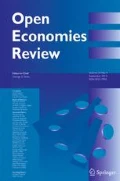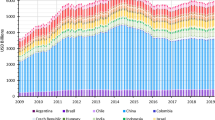Abstract
We review the conduct and scale of official intervention by monetary authorities in the U.S.A., Japan, and West Germany since the Plaza Agreement. Relative to trading volume and the stock of internatonally traded assets denominated in foreign currencies, intervention is small-scale and sporadic, hence at best limited to transitory effects. It does not appear to reduce volatility of daily exchange rates. Monetary authorities gamble that they will not suffer losses on their foreign currency holdings. Evidence in favor of sterilized foreign exchange market intervention as a way of conveying information to the private sector is far from convincing. Since changes in relative monetary growth rates are sufficient to alter bilateral exchange rates, monetary authorities can achieve their exchange rate preferences with domestic monetary policy, but at the cost of possible distortionary effects on monetary growth rates, domestic interest rates, and international capital flows.
Similar content being viewed by others
References
Auerbach, Robert D. (1990) “A Budgetary Bias for United States Intervention in Foreign Exchange Markets,”Public Budgeting and Financial Management 1 (Winter), (forthcoming).
Bank of International Settlements (1990) “Survey of Foreign Exchange Market Activity,” Monetary and Economic Department Basle.
Dominguez, Kathryn M. (1988). “The Informational Role of Official Foreign Exchange Intervention Operations: An Empirical Investigation,” mimeo, Cambridge: Harvard University.
Dominguez, Kathryn M. (1989) “Market Response to Coordinated Central Bank Intervention”, NBER Working Paper No. 3192.
Dominguez, Kathryn M. and Jeffrey Frankel (1990) “Does Foreign Exchange Intervention Matter? Disentangling the Portfolio and Expectations Effects for the Mark,” NBER Working Paper No. 3299.
Dornbusch, Rudiger and Jeffey Frankel (1987) “The Flexible Exchange Rate System: Experience and Alternatives,” NBER Working Paper No. 2464.
Fase, M. M. G. and A. P. Huijser (1989) “The Profitability of Official Foregn Exchange Market Intervention: A Case Study for the Netherlands 1974–1989,” Research Memorandum no. 8821, De Nederlandsche Bank.
Frankel, Jeffrey (1982) “In Search of the Exchange Risk Premium: A Six-Currency Test Assuming Mean-Variance Optimization,”Journal of International Money and Finance 1, 255–274.
Hodrick, Robert J. (1987)The Empirical Evidence on the Efficiency of Forward and Futures Foreign Exchange Markets, Fundamentals of Pure and Applied Economics no. 24. Chur, Switzerland: Harwood Academic Publishers.
Leahy, Michael P. (1989). “The Profitability of U.S. Intervention,” International Finance Discussion Papers No. 343, Board of Governors of the Federal Reserve System.
Loopesko, Bonnie E. (1984) “Relationships among Exchange Rates, Intervention, and Interest Rates: An Empirical Investigation,”Journal of International Money and Finance 3, 257–277.
Marston, Richard C. (1988). “Exchange Rate Policy Reconsidered,” Ch. 2.1. In Martin Feldstein (ed),International Economic Cooperation. Chicago: University of Chicago Press, pp. 79–136.
Mussa, Michael (1979) “Empirical Regularities in the Behavior of Exchange Rates and Theories of the Foreign Exchange Market.” In K. Brunner and A. H. Meltzer (eds), Policies for Employment, Prices, and Exchange Rates. Carnegie Rochester Conference Series, vol. 11.
Mussa, Michael (1981) “The Role of Official Intervention,” Group of Thirty Occasional Papers No. 6.
Obstfeld, Maurice (1988) “The Effectiveness of Foreign-Exchange Intervention: Recent Experience,” NBER Working Paper No. 2796.
Rich, Georg (1989) “Exchange Rate Management Under Floating Exchange Rates: A Skeptical Swiss View” mimeo, Swiss National Bank.
Rogoff, Kenneth (1984) “On the Effects of Sterilized Intervention: An Analysis of Weekly Data,”Journal of Monetary Economics 14, 133–150.
Summers, Lawrence (1989) “What To Do When Japan Says ‘No’,”The New York Times Dec. 3, section 3, p. 2.
von Hagen, Jürgen (1989) “Monetary Targeting with Exchange Rate Constraints: The Bundesbank in the 1980s,” Federal Reserve Bank of St. Louis.Review 71 No. 5, 53–69.
Author information
Authors and Affiliations
Rights and permissions
About this article
Cite this article
Bordo, M.D., Schwartz, A.J. What has foreign exchange market intervention since the Plaza Agreement accomplished?. Open Econ Rev 2, 39–64 (1991). https://doi.org/10.1007/BF01886134
Issue Date:
DOI: https://doi.org/10.1007/BF01886134




